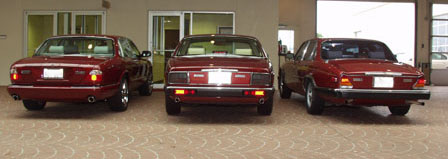| |||||||||||
| |||||||||||


Since it was first unveiled in 1968, the XJ6 name has been carried by five models. The first three are differentiated only by slight styling or mechanical variations, sharing the same basic bodyshell and engine. While the fourth and fifth "XJ6's" do carry the nameplate, they incorporate major body, mechanical and electrical redesigns, share almost nothing with the earlier cars, and are rightly considered separate and distinct models. The terminology for the different versions of the XJ6 are: Series I (1968 to 73), Series II (1973 to 1979), Series III (1979 to 1986 in Europe and 1987 in the US), XJ40 (1987 or 1988 to 1994), and X300 (1995 to 1997). Unfortunately, the fact that all three basic types of cars carry the exact same external model name makes it a little difficult for the lay person to correctly determine which model or series they have. Adding to this difficulty is the fact that the X300 was deliberately styled to look like the Series III cars! There is a great deal of confusion possible here. Add in the XJ12 and later, the XJ8 models, and, well... Let's just say that even the cognoscenti can become confused. Often, someone with a car badged "XJ" will join the XJ list, only to find out that the participants know nothing about their car, because it is 'something called an X300?'. Or, someone with a 1987 XJ6 will join the Moderns list, thinking that that's where they belong, when they really have a late Series III and belong on the XJ list. While we here at Jag-Lovers don't really mind this sort of thing, it does tend to waste your valuable time. (Which could be spent polishing or working on your beloved Jaguar!) More importantly, it tends to confuse potential members, who get answers to their questions quickly, but unfortunately those answers bear absolutely no resemblance to what they see in their car. This guide has been created to assist in the proper identification of cars made after 1985. If your car was made in or prior to 1985, please refer to the dates above to determine which of the three series of the original XJ you have. If your car was made after 1985, please read on to determine which of these cars you have, and which of our resources here at Jag-Lovers will best suit your needs. Click on any picture to view a larger and more detailed version. Click on the text that describes your automobile to discover which version you have and where you can best get information and assistance about it on Jag-Lovers. Special thanks must be extended to Millennium Motorcars, the Jaguar dealer in Plano, Texas. They courteously made room in their beautiful indoor service drive for this photo shoot when the original location became unavailable due to weather, and graciously loaned us the 2001 X300 'XJR' to complete the set of three red Jaguars. Credits And Acknowledgements | Why are they called XJ/XJ40/X300? What's the difference?

This author's profound thanks for assistance on this page and
article go out to: This subject has formed the basis for a number of learned books on the matter, but in a nutshell: In 1968, Sir William Lyons, founder of Jaguar, unveiled his final sedan design to the world, the XJ6. The Series I thru Series III XJ's are what many consider to be the definitive modern Jaguar sedans. The engine most commonly found in these models was the twin overhead cam 4.2L inline 6 cylinder engine derived from the classic Jaguar XK racing motor. Other engines which were offered included the 2.8L and 3.4L inline 6 and the glorious 5.3L V12. The Series I became the Series II in 1974, with a more "modern" grille being the chief external difference, and the later introduction of the coupe and long wheelbase models. In 1979, the design was revised with assistance from the Italian design bureau of Pininfarina, creating the Series III. In the US market, the Series III terminated with the XJ6 in 1987, but in other markets (notably Canada) the design soldiered on in the form of the XJ12 until the XJ40-based replacement arrived in 1993. The Series III was originally intended as a stop-gap model; something to keep the wolves from the door while the replacement for the original (then 10-year-old design) was designed and built. However, it ended up becoming the most numerous of the three series because the design, code-named "XJ40" and begun in the 70's, was repeatedly delayed. When the XJ40 (badged as an "XJ6" finally appeared after a (reportedly) 14 year gestation, it replaced the Series III slowly; introduced in Europe in 1986, it was produced alongside Series III cars for the US market until 1987, when the original XJ6 was killed off. By this time, Jaguar had more or less perfected the design of the XJ, and was well on the way to having a reputation as a builder of reliable, refined, and interesting luxury sporting sedans after the quality debacle from the late 70's under the British Leyland conglomerate until 1981-82 (just after Jaguar left the conglomerate). Due to some disturbing proposals by Jaguar's former parent corporation, British Leyland, the XJ40 was deliberately designed so as to be unable to have a V-configuration engine of any sort. The engine bay was specifically designed for a slant six; in preventing the installation of the Rover V8 truck engine, the designers denied Jaguar a V12 variant of the XJ40. In order to not lose sales, Jaguar continued to build Series III XJ12's on almost a one-off basis until the redesigned XJ40 engine bay made it into production in 1993. Since the United States did not receive any XJ12's during the Series III run due to government regulations, many Americans are unaware of the continuance of the line until 1992. Likewise, many other markets are unaware that the original XJ6 made it into 1987 before being killed off. Of course, these staggered dates of production tend to confuse people when discussing their cars. The XJ40 was a clean-sheet design, sharing almost nothing with it's predecessor. It was designed to look like a Jaguar, while being much easier and cheaper for the (then) struggling company to make. It was a roomy design, but there was much debate about the largely boxy look of the new sedan. Many thought that it wasn't as distinctive as a Jaguar sedan should be, while others liked it. The XJ40 was also powered by a new family of engines initially, the AJ6 and later the AJ16 slant-six engines, in displacements from 2.9L to 4.0L; the later, XJ12 versions received a revised 6.0L version of the mighty Jaguar 5.3L V12. Unfortunately, the XJ40 suffered from quality control and design problems its first few years (86-90, especially) and did much to damage the reputation of Jaguar. Door handles breaking off, self-levelling suspension that didn't, computers that reported non-existent problems, and fragile interior trim put many people off. Eventually all these problems were corrected, but the damage was done. Jaguar fell on hard times and was bought out by Ford in 1990. However, even before the Ford buy-out, forces of renewal were on the move at Coventry. The replacement for the boxy-looking XJ40 was on the drawing boards, and the project, named X300, bore a familiar-looking face; that of the Series III! The X300 was a restyle of the XJ40 to look like the Series III in an effort to increase sales. In addition, many of the XJ40's trouble areas were redesigned or eliminated. This car replaced the XJ40, worldwide, in 1995, with an XJ6 and an XJ12 version (and the same engines as its predecessor). Both of these were scrapped when the Jaguar AJ-V8, an engine design also in progress since before the buy-out, made it into production in the 1998 models as the XJ8. As of this writing, July of 2001, it is the current model bearing the "XJ" series name. There is a rumor that this car is slated to be replaced in 2003 with a Ford-corporate-platform badge-engineered model, but only time will tell... Notice: ALL COMMERCIAL USE OF THE MATERIAL FOUND AT THIS SITE IS STRICTLY PROHIBITED! NON-COMMERCIAL USERS (CLUB NEWSLETTERS ETC.): BEFORE USING MATERIAL FOUND HERE, BE SURE TO ASK PERMISSION OF AUTHOR. MAKE SURE TO CREDIT THE AUTHOR AND INDICATE WHERE YOU FOUND THE MATERIAL (URL). |
|
| ||
 |
Improve your Jag-lovers experience with the Mozilla FireFox Browser!
©Jag-loversTM Ltd / JagWEBTM 1993 - 2024 All rights reserved. Jag-lovers is supported by JagWEBTM For Terms of Use and General Rules see our Disclaimer Use of the Jag-lovers logo or trademark name on sites other than Jag-lovers itself in a manner implying endorsement of commercial activities whatsoever is prohibited. Sections of this Web Site may publish members and visitors comments, opinion and photographs/images - Jag-lovers Ltd does not assume or have any responsibility or any liability for members comments or opinions, nor does it claim ownership or copyright of any material that belongs to the original poster including images. The word 'Jaguar' and the leaping cat device, whether used separately or in combination, are registered trademarks and are the property of Jaguar Cars, England. Some images may also be © Jaguar Cars. Mirroring or downloading of this site or the publication of material or any extracts therefrom in original or altered form from these pages onto other sites (including reproduction by any other Jaguar enthusiast sites) without express permission violates Jag-lovers Ltd copyright and is prohibited |
 |